Global Wearable Robotic Exoskeleton Market, By Type, By Application, By Functionality, By Technology, By End User, By Region & Segmental Insights Trends and Forecast, 2024 – 2034
- Industry: Semiconductors & Electronics
- Report ID: TNR-110-1312
- Number of Pages: 420
- Table/Charts : Yes
- September, 2024
- Base Year : 2024
- No. of Companies : 10+
- No. of Countries : 29
- Views : 10145
- Covid Impact Covered: Yes
- War Impact Covered: Yes
- Formats : PDF, Excel, PPT
Wearable robotic exoskeletons are advanced devices designed to augment or enhance the physical capabilities of users through mechanical support and powered assistance. These exoskeletons find applications across various sectors, transforming how tasks are performed and enhancing human capabilities. In healthcare, they aid rehabilitation and mobility for patients with disabilities, such as ReWalk’s exoskeleton, which helped a paralyzed man walk in 2014.
In industry, they reduce fatigue and improve safety, like the Ekso Bionics’ Exoskeleton used in automotive manufacturing for lifting heavy parts. The military utilizes exoskeletons to boost soldier endurance and strength, as seen with the U.S. Army’s Tactical Assault Light Operator Suit (TALOS), developed in 2013. In sports, companies like SuitX are enhancing performance and injury prevention for athletes. These innovations highlight the growing importance of exoskeletons in improving quality of life and operational efficiency across various fields. “In Terms of Revenue, the Global Wearable Robotic Exoskeleton Market was Worth US$ 1.3 Bn in 2023, Anticipated to Witness CAGR of 44.3% During 2024 – 2034.”
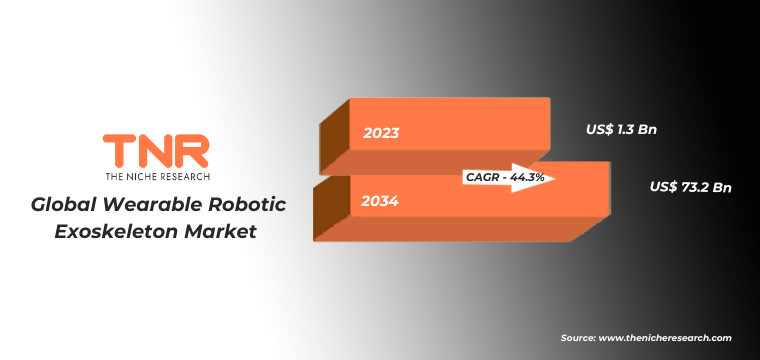
Major Manufacturers Approach and Strategies in the Global Wearable Robotic Exoskeleton Market:
Major manufacturers in the global wearable robotic exoskeleton market focus on innovation, strategic partnerships, and expanding applications. For example, Ekso Bionics, in 2017, partnered with rehabilitation centers to enhance mobility solutions for patients. Similarly, ReWalk Robotics secured FDA approval in 2014, strengthening its presence in healthcare.
Companies like Hyundai, since 2018, have integrated exoskeletons into industrial settings to boost worker safety and productivity. These manufacturers are also investing in research and development to improve exoskeleton technology, addressing needs in healthcare, industry, and military sectors.
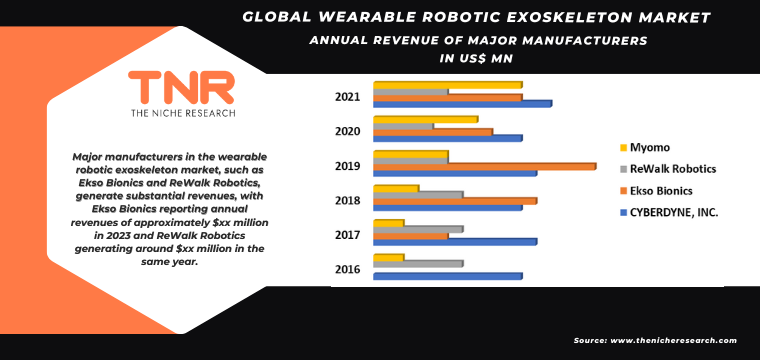
Growth Drivers in the Global Wearable Robotic Exoskeleton Market
- Technological Advancements: Innovations in robotics and artificial intelligence drive market growth, exemplified by the advanced functionalities of the ReWalk exoskeleton, which gained FDA approval in 2014 for improving mobility in paraplegic patients.
- Increasing Aging Population: The growing elderly population spurs demand for mobility aids, such as the Ekso Bionics’ Exoskeleton, which helps seniors maintain independence and reduce fall risk, addressing mobility challenges in an aging society.
- Rising Industrial Safety Concerns: Enhanced worker safety and productivity are crucial, with companies like Hyundai deploying wearable exoskeletons in 2018 to reduce musculoskeletal injuries and improve efficiency in their manufacturing processes.
Restraints in the Global Wearable Robotic Exoskeleton Market
- High Costs: The expense of wearable robotic exoskeletons can be prohibitive, as seen with the $77,000 price tag of the ReWalk exoskeleton. This limits accessibility for widespread adoption, particularly in low-budget healthcare settings.
- Limited Battery Life: Many exoskeletons struggle with battery limitations, affecting usability. For example, the Ekso Bionics’ Exoskeleton, introduced in 2015, has faced criticism for requiring frequent recharging during extended use, impacting operational efficiency.
- Complexity of Use: Exoskeletons can be challenging to operate and require extensive training. The HAL exoskeleton, used in rehabilitation, demands careful user training to ensure effective use, complicating its integration into everyday healthcare practices.
Global Wearable Robotic Exoskeleton Market Segmental Analysis
By Type
Active exoskeletons dominate the global wearable robotic exoskeleton market, contributing 43.7% to revenue share due to their powered assistance and adaptability across sectors. For instance, Ekso Bionics’ active exoskeleton, launched in 2017, enables paraplegic patients to walk through motorized support. In industries, Hyundai introduced an active exoskeleton in 2018 to assist workers in lifting heavy objects, reducing fatigue and injury risk. This technology’s versatility in healthcare, industrial, and military applications drives its widespread adoption and market leadership.
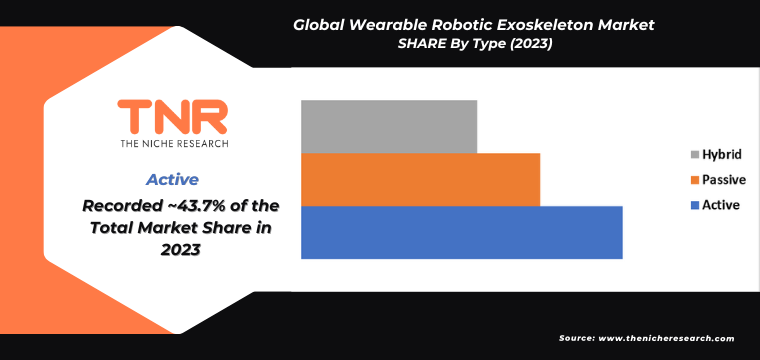
By Application
In 2023, the rehabilitation segment accounted for 28.2% of the global wearable robotic exoskeleton market, becoming the second-largest application category. These exoskeletons are transforming rehabilitation, aiding stroke and spinal cord injury patients. For example, ReWalk’s exoskeleton, FDA-approved in 2014, helps paraplegic individuals regain mobility, while Ekso Bionics’ devices, introduced in 2017, assist in physical therapy by enabling users to walk during rehab. Their integration in healthcare facilities worldwide demonstrates their growing role in improving patient outcomes and accelerating recovery processes.
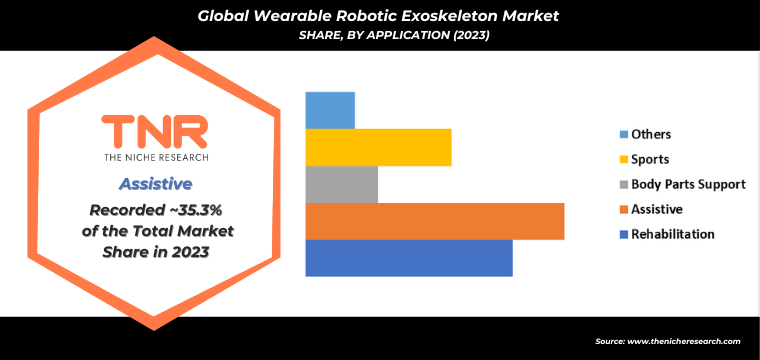
By Functionality
The upper body exoskeletons segment is set to be the fastest-growing functionality in the global wearable robotic exoskeleton market, projected to account for 47.6% of the revenue share. These exoskeletons are increasingly used in industries for tasks involving heavy lifting and repetitive movements. For instance, SuitX’s shoulder-supporting exoskeleton, introduced in 2018, reduces worker fatigue and injury risks in manufacturing. Similarly, Ford implemented EksoVest in 2017, allowing workers to perform overhead tasks with less strain. These advancements highlight their vital role in enhancing productivity and safety across various industries.
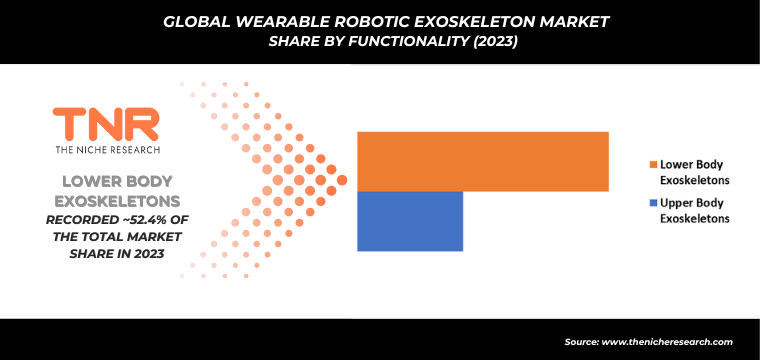
By Technology
Electric segment by technology dominated the global wearable robotic exoskeleton market, capturing 39.5% of revenue share due to its precision and efficiency. Electric exoskeletons like ReWalk, approved by the FDA in 2014, offer powered assistance, enabling users to perform tasks with greater control and mobility. Similarly, Ekso Bionics’ electric-powered exoskeleton, used in rehabilitation and industrial applications since 2017, enhances human strength and reduces fatigue. These electric systems are favored for their ability to deliver consistent power, making them crucial across healthcare and industrial sectors.
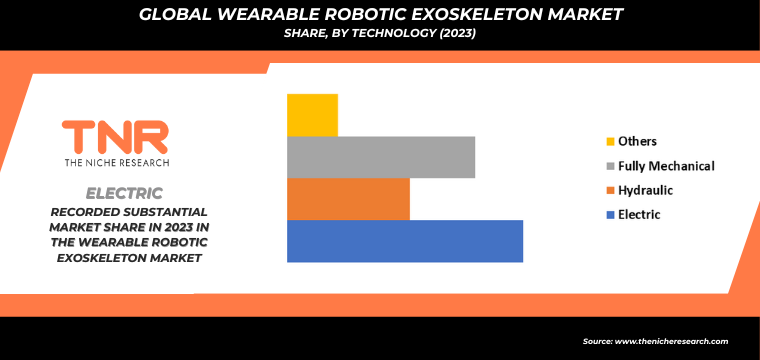
By End User
Hospitals and clinics are expected to be the fastest-growing end-user segment in the wearable robotic exoskeleton market, capturing 18.4% of the revenue share. This growth is driven by increased adoption of exoskeletons for rehabilitation and mobility assistance. For example, in 2017, Ekso Bionics’ exoskeleton was introduced in rehabilitation centers to help stroke and spinal cord injury patients regain movement. Similarly, ReWalk, FDA-approved in 2014, is being utilized in hospitals to improve patient mobility. These technologies significantly enhance recovery outcomes, making them essential in modern healthcare settings.
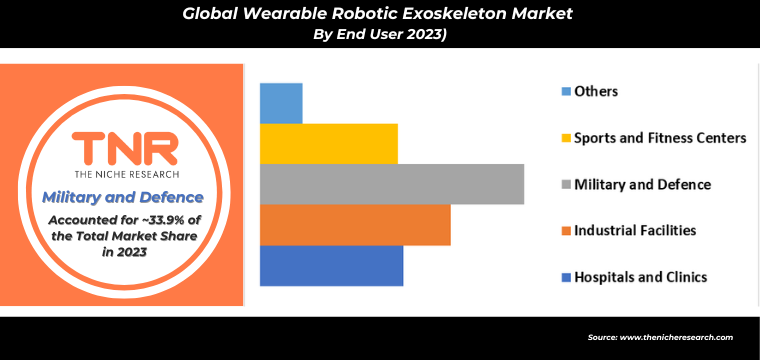
By Region
In 2023, Europe reinforced its third leading position in the global wearable robotic exoskeleton market, capturing a significant revenue share of 21.5%. The region’s growth is driven by rising healthcare investments and industrial applications. For instance, Ekso Bionics’ exoskeleton was introduced in European hospitals in 2017 for rehabilitation therapy. Additionally, German automotive manufacturers like BMW have implemented robotic exoskeletons since 2018 to enhance worker efficiency and reduce fatigue. Europe’s focus on healthcare innovation and industrial safety continues to fuel the market’s expansion in the region.
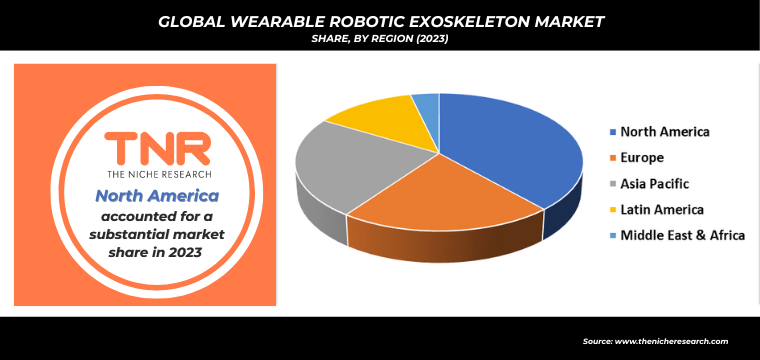
Competitive Landscape
Some of the players operating in the wearable robotic exoskeleton market are
- Bionik Laboratories Corp.
- CYBERDYNE, INC.
- Ekso Bionics
- ExoAtlet
- Hocoma
- Lockheed Martin
- ReWalk Robotics
- Rex Bionics Pty Ltd.
- Sarcos Corp.
- Wearable Robotics Srl
- Other Industry Participants
Global Wearable Robotic Exoskeleton Market Scope:
| Report Specifications | Details |
| Market Revenue in 2023 | US$ 1.3 Bn |
| Market Size Forecast by 2034 | US$ 73.2 Bn |
| Growth Rate (CAGR) | 44.3% |
| Historic Data | 2016 – 2022 |
| Base Year for Estimation | 2023 |
| Forecast Period | 2024 – 2034 |
| Report Inclusions | Market Size & Estimates, Market Dynamics, Competitive Scenario, Trends, Growth Factors, Market Determinants, Key Investment Segmentation, Product/Service/Solutions Benchmarking |
| Segments Covered | By Type, By Application, By Functionality, By Technology, By End User, By Region |
| Regions Covered | North America, Europe, Asia Pacific, Middle East & Africa, Latin America |
| Countries Covered | U.S., Canada, Mexico, Rest of North America, France, The UK, Spain, Germany, Italy, Nordic Countries (Denmark, Finland, Iceland, Sweden, Norway), Benelux Union (Belgium, The Netherlands, Luxembourg), Rest of Europe, China, Japan, India, New Zealand, Australia, South Korea, Southeast Asia (Indonesia, Thailand, Malaysia, Singapore, Rest of Southeast Asia), Rest of Asia Pacific, Saudi Arabia, UAE, Egypt, Kuwait, South Africa, Rest of Middle East & Africa, Brazil, Argentina, Rest of Latin America |
| Key Players | Bionik Laboratories Corp., CYBERDYNE, INC., Ekso Bionics, ExoAtlet, Hocoma, Lockheed Martin, ReWalk Robotics, Rex Bionics Pty Ltd., Sarcos Corp., Wearable Robotics Srl |
| Customization Scope | Customization allows for the inclusion/modification of content pertaining to geographical regions, countries, and specific market segments. |
| Pricing & Procurement Options | Explore purchase options tailored to your specific research requirements |
| Contact Details | Consult With Our Expert
Japan (Toll-Free): +81 663-386-8111 South Korea (Toll-Free): +82-808- 703-126 Saudi Arabia (Toll-Free): +966 800-850-1643 United Kingdom: +44 753-710-5080 United States: +1 302-232-5106 E-mail: askanexpert@thenicheresearch.com
|
Global Wearable Robotic Exoskeleton Market
By Type
- Active
- Passive
- Hybrid
By Application
- Rehabilitation
- Assistive
- Body Parts Support
- Sports
- Others
By Functionality
- Upper Body Exoskeletons
- Lower Body Exoskeletons
By Technology
- Electric
- Hydraulic
- Fully Mechanical
- Others
By End User
- Hospitals and Clinics
- Industrial Facilities
- Military and Defence
- Sports and Fitness Centers
- Others
By Region
- North America (U.S., Canada, Mexico, Rest of North America)
- Europe (France, The UK, Spain, Germany, Italy, Nordic Countries (Denmark, Finland, Iceland, Sweden, Norway), Benelux Union (Belgium, The Netherlands, Luxembourg), Rest of Europe)
- Asia Pacific (China, Japan, India, New Zealand, Australia, South Korea, Southeast Asia (Indonesia, Thailand, Malaysia, Singapore, Rest of Southeast Asia), Rest of Asia Pacific)
- Middle East & Africa (Saudi Arabia, UAE, Egypt, Kuwait, South Africa, Rest of Middle East & Africa)
- Latin America (Brazil, Argentina, Rest of Latin America)
Report Layout:
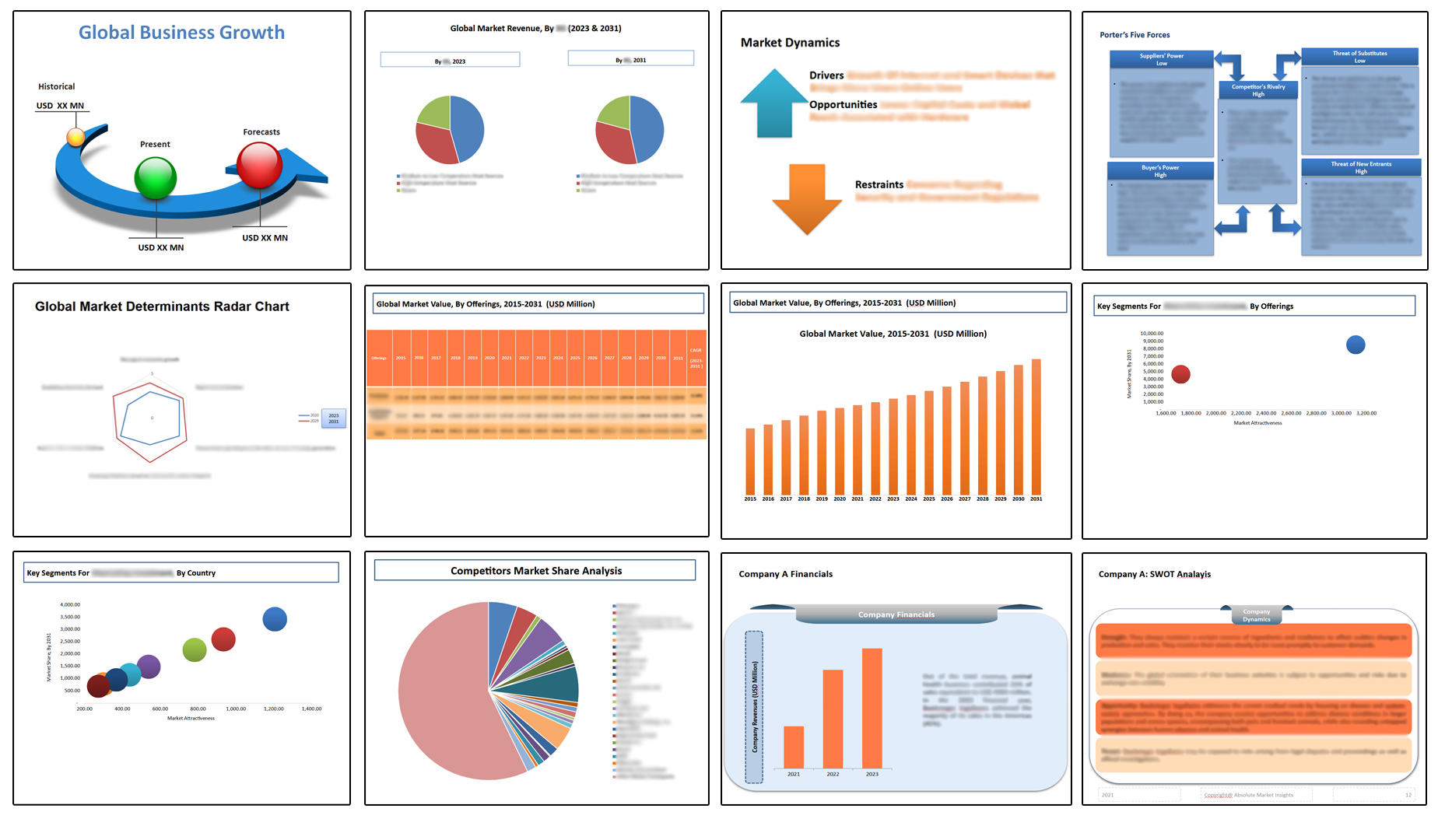
Table of Contents
Note: This ToC is tentative and can be changed according to the research study conducted during the course of report completion.
**Exclusive for Multi-User and Enterprise User.
Global Wearable Robotic Exoskeleton Market
By Type
- Active
- Passive
- Hybrid
By Application
- Rehabilitation
- Assistive
- Body Parts Support
- Sports
- Others
By Functionality
- Upper Body Exoskeletons
- Lower Body Exoskeletons
By Technology
- Electric
- Hydraulic
- Fully Mechanical
- Others
By End User
- Hospitals and Clinics
- Industrial Facilities
- Military and Defence
- Sports and Fitness Centers
- Others
By Region
- North America (U.S., Canada, Mexico, Rest of North America)
- Europe (France, The UK, Spain, Germany, Italy, Nordic Countries (Denmark, Finland, Iceland, Sweden, Norway), Benelux Union (Belgium, The Netherlands, Luxembourg), Rest of Europe)
- Asia Pacific (China, Japan, India, New Zealand, Australia, South Korea, Southeast Asia (Indonesia, Thailand, Malaysia, Singapore, Rest of Southeast Asia), Rest of Asia Pacific)
- Middle East & Africa (Saudi Arabia, UAE, Egypt, Kuwait, South Africa, Rest of Middle East & Africa)
- Latin America (Brazil, Argentina, Rest of Latin America)
The Niche Research approach encompasses both primary and secondary research methods to provide comprehensive insights. While primary research is the cornerstone of our studies, we also incorporate secondary research sources such as company annual reports, premium industry databases, press releases, industry journals, and white papers.
Within our primary research, we actively engage with various industry stakeholders, conducting paid interviews and surveys. Our meticulous analysis extends to every market participant in major countries, allowing us to thoroughly examine their portfolios, calculate market shares, and segment revenues.
Our data collection primarily focuses on individual countries within our research scope, enabling us to estimate regional market sizes. Typically, we employ a bottom-up approach, meticulously tracking trends in different countries. We analyze growth drivers, constraints, technological innovations, and opportunities for each country, ultimately arriving at regional figures.Our process begins by examining the growth prospects of each country. Building upon these insights, we project growth and trends for the entire region. Finally, we utilize our proprietary model to refine estimations and forecasts.
Our data validation standards are integral to ensuring the reliability and accuracy of our research findings. Here’s a breakdown of our data validation processes and the stakeholders we engage with during our primary research:
- Supply Side Analysis: We initiate a supply side analysis by directly contacting market participants, through telephonic interviews and questionnaires containing both open-ended and close-ended questions. We gather information on their portfolios, segment revenues, developments, and growth strategies.
- Demand Side Analysis: To gain insights into adoption trends and consumer preferences, we reach out to target customers and users (non-vendors). This information forms a vital part of the qualitative analysis section of our reports, covering market dynamics, adoption trends, consumer behavior, spending patterns, and other related aspects.
- Consultant Insights: We tap into the expertise of our partner consultants from around the world to obtain their unique viewpoints and perspectives. Their insights contribute to a well-rounded understanding of the markets under investigation.
- In-House Validation: To ensure data accuracy and reliability, we conduct cross-validation of data points and information through our in-house team of consultants and utilize advanced data modeling tools for thorough verification.
The forecasts we provide are based on a comprehensive assessment of various factors, including:
- Market Trends and Past Performance (Last Five Years): We accurately analyze market trends and performance data from preceding five years to identify historical patterns and understand the market’s evolution.
- Historical Performance and Growth of Market Participants: We assess the historical performance and growth trajectories of key market participants. This analysis provides insights into the competitive landscape and individual company strategies.
- Market Determinants Impact Analysis (Next Eight Years): We conduct a rigorous analysis of the factors that are projected to influence the market over the next eight years. This includes assessing both internal and external determinants that can shape market dynamics.
- Drivers and Challenges for the Forecast Period:Identify the factors expected to drive market growth during the forecast period, as well as the challenges that the industry may face. This analysis aids in deriving an accurate growth rate projection.
- New Acquisitions, Collaborations, or Partnerships: We keep a close watch on any new acquisitions, collaborations, or partnerships within the industry. These developments can have a significant impact on market dynamics and competitiveness.
- Macro and Micro Factors Analysis:A thorough examination of both macro-level factors (e.g., economic trends, regulatory changes) and micro-level factors (e.g., technological advancements, consumer preferences) that may influence the market during the forecast period.
- End-User Sentiment Analysis: To understand the market from the end-user perspective, we conduct sentiment analysis. This involves assessing the sentiment, preferences, and feedback of the end-users, which can provide valuable insights into market trends.
- Perspective of Primary Participants: Insights gathered directly from primary research participants play a crucial role in shaping our forecasts. Their perspectives and experiences provide valuable qualitative data.
- Year-on-Year Growth Trend: We utilize a year-on-year growth trend based on historical market growth and expected future trends. This helps in formulating our growth projections, aligning them with the market’s historical performance.
Research process adopted by TNR involves multiple stages, including data collection, validation, quality checks, and presentation. It’s crucial that the data and information we provide add value to your existing market understanding and expertise. We have also established partnerships with business consulting, research, and survey organizations across regions and globally to collaborate on regional analysis and data validation, ensuring the highest level of accuracy and reliability in our reports.








